Employee Milestones & Tidbits – Q1 2021
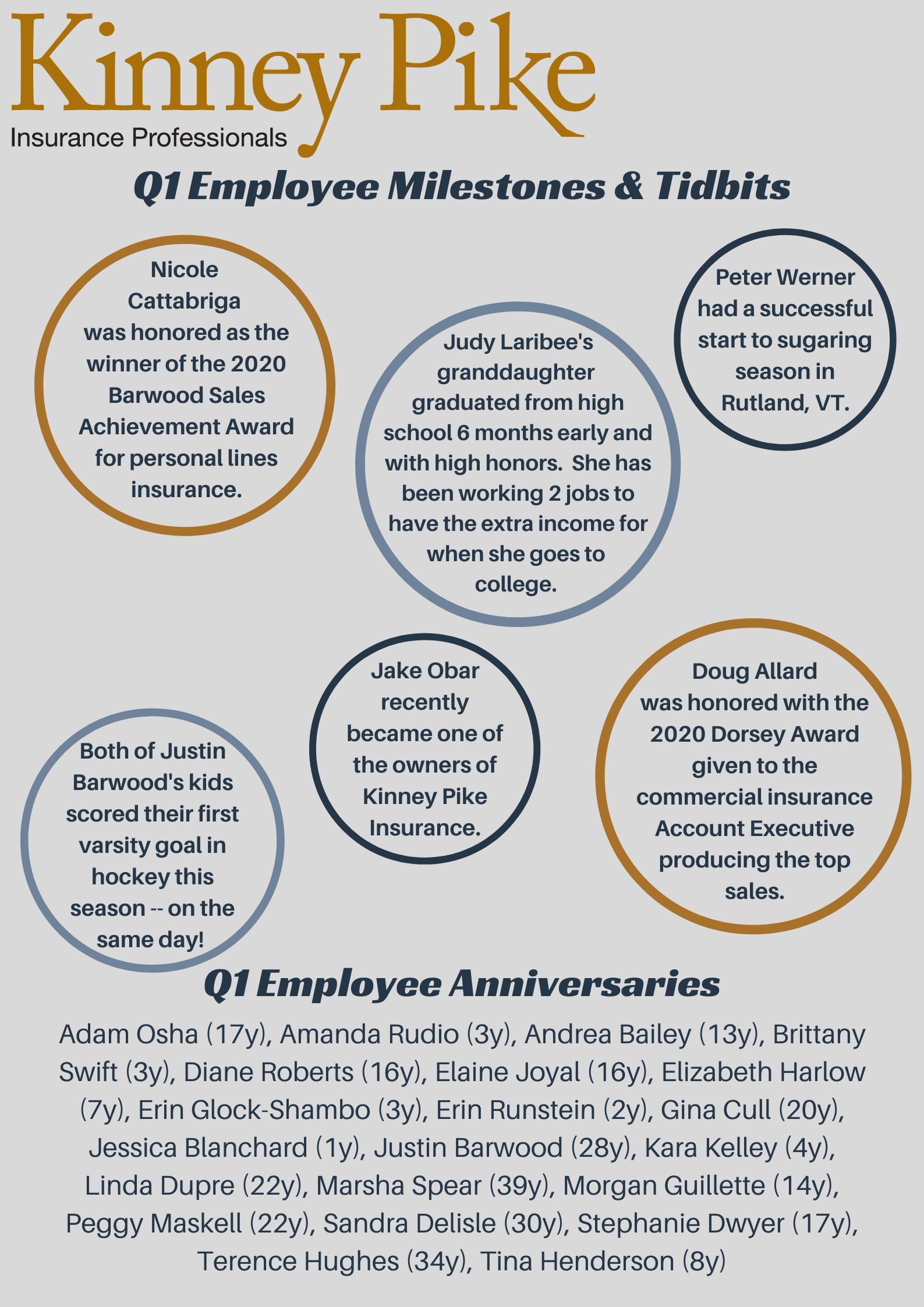



After a harsh New England winter, it’s important that you tidy up your commercial properties to protect your customers, staff, and greater community from any potential slip, trip & fall hazards.
Whether that responsibility falls on you, the property owner or you hire an outside property management company to take care of these things for you, we recommend creating a checklist & then closely inspecting your building and landscaping. Take note of any damage — if you have a camera and can take pictures, that is even better.
If a whole checklist seems overwhelming or you are not sure where to begin, here are some areas we suggest you focus on this spring:
Trees & Shrubs – The weight of heavy snow and ice can often wreak havoc on our outdoor environments. As heavy ice accumulates, it is not uncommon to see split, dead, and/or rotting trees & shrubs because of the harsh seasonal conditions. Trim any dead branches that may be on your property or near powerlines. Until removed, these will continue to be a risk, falling on a person, building, or vehicle, presenting a very serious safety concern.
It is important to trim any healthy trees & shrubs as well, to keep them under control and away from wires.
Roof & Gutters – Check your roof for any damages that may have been caused during the winter from ice or snow and repair them to reduce the chance of leaks. Signs of damage to your commercial roof can be as subtle as water spots on interior ceilings and walls or as obvious as a major leak.
While you have the ladder out, it is a good idea to clean out the gutters too. This will keep the water flowing away from your business and prevent the possibility of damage and leaks. Proper water drainage throughout your property is also important, as stagnant, or pooling water can come with its own set of risks.
Parking Lot & Walkways – Spring is the perfect time to get outside, and conduct slip, trip & fall hazards around your parking areas & walkways. Potholes in concrete and asphalt not only create tripping hazards but can also collect water. Fill potholes with gravel or paver base as a temporary fix, but have a permanent repair done as soon as possible.
Engine oil and coolant residue left on parking surfaces can be slippery in any type of weather. Clean it up with a pressure washer before or after normal business hours to avoid inconveniencing any customers or employees.
Clear any salt/sand leftover from winter in your parking area & walkways. If not handled properly, this can build up over time and create additional slip, trip, fall hazards.
If you need and/or want to hire a property management company to handle the above tasks, we are happy to provide you with a list of recommendations.
Sources:
https://www.acadiainsurance.com/after-the-thaw-6-tips-for-spring-commercial-property-maintenance/
https://www.clintar.com/blog/2021/02/25/spring-maintenance-for-commercial-properties-2021/
https://www.emcins.com/losscontrol/insights-d/newsletters/petro/2015/05-1/
https://www.klimroofing.com/2019/06/27/roofing/the-basics-of-commercial-roof-maintenance/
Although spring has sprung throughout most of New England, it’s never too early to start thinking about NEXT winter. According to our claim’s specialist, Beth Sawyer there have been a large amount of ice dam claims this winter season; an issue that is more common than one might think.
If you don’t know what an ice dam is, it’s a ridge of ice that typically forms along the edge of a roof and prevents melting snow from draining off of the roof. This in turn can create major issues, including backed up water from the ice melt leaking into your roof, which can cause water damage on the ceiling & walls. If this is not caught in time it can lead to an even bigger issue – MOLD.
Here is an infographic from Family Handy Man that helps explain ice dams better:
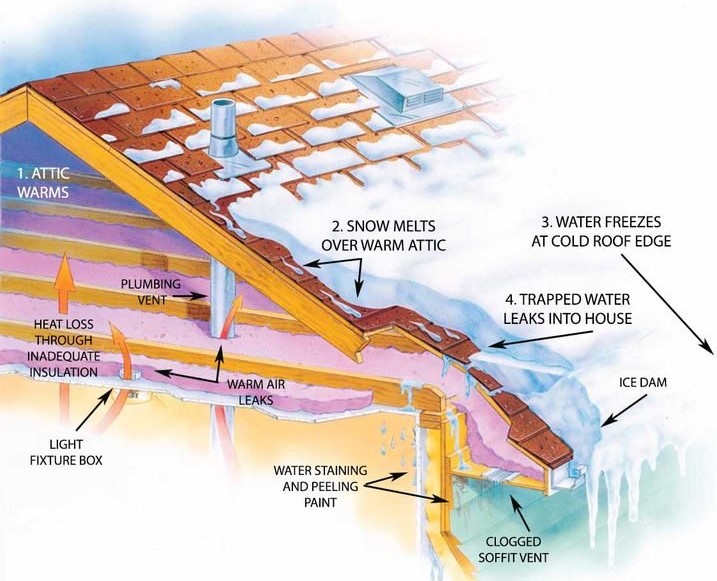
At this point, you’re probably wondering if your home might be susceptible to ice dams and what you can do to prevent this from happening… let us break it down for you:
Most ice dams form as a result of improper insulation and air sealing of a house. Contrary to what many people believe, a cold attic actually means no ice dams, while a warm attic means “homeowner beware.” Also, how much direct sunlight your home gets is another contributing factor. The most common areas of a home for ice dams to form are:
Ice dam removal can be a pain, so the best course of action is to try to prevent them from forming in the first place. Here are some things you can do before next winter comes around.
Insulation: Most newer attics are insulated with today’s energy standards, which include fiberglass insulation. This minimizes heat escaping through the ceiling, virtually eliminating the possibility of snow melting and refreezing at the base of the roof. However, If your home was built before 1980, it probably needs more insulation. If you have an open attic, this means insulating the floor of the attic. If you have a finished second story in which a finished ceiling is directly against the roof, this means insulating the rafter spaces (in combination with ventilation). Insulation levels are recommended by geographic zones and are stated in R-values. Read more about proper home insulation here.
Ventilation: Unfortunately, insulation alone rarely is enough to prevent ice dams. It needs to be done in conjunction with better ventilation and venting your roof can be complicated. One option is to install additional roof vents and soffit vents, which can move the hot air from your attic to the exterior of your home. You also want to find and seal all of your attic bypasses. These included anywhere your walls or ceilings are penetrated (e.g., ceiling fans, ceiling lights, smoke detectors, etc.). If a hole was cut in your ceiling or wall to install something, that is a potential air leak into your attic. Other possible sources of heat venting into your attic include uninsulated HVAC ductwork, vents from clothes dryers, or improperly vented bathroom or kitchen exhaust fans. All of these heat sources should be wrapped in fiberglass insulation to reduce heat in the attic space.
Heat Cables & Heat Pucks: If updating insulation & ventilation is still not enough to prevent ice dams or maybe you just do not have the resources available to do the above, heat cables & heat pucks can be a great temporary solution. Heat cables are high-resistance wires that you mount on the roof edge in a zigzag pattern and plug into an outdoor receptacle. Ideally, they should go in spots where ice dams regularly occur and cannot be stopped by any other means. Heat pucks are small, circular discs made with calcium chloride that you can throw up on roofs to melt ice in hard-to-reach places. There are mixed reviews about heat pucks, but they might be worth a shot if you are unable to do any of the other suggestions we have mentioned.
Snow Rake your Roof: A snow rake is an aluminum scraper mounted at a right angle on a telescoping pole. The theory is if you pull the snow down off your roof, it will not be able to melt and form an ice dam. This method is most effective right after a big snowstorm, and typically can only be done on one-story homes (never use a snow rake when standing on a ladder OR get on your roof to remove the snow). This can be a simple but tedious solution, and be wary not to ruin your shingles.
We realize all this information can all be quite overwhelming. If all else fails and ice dam buildup is too much for you to handle, it might be time to call a professional. We are happy to share some names of local contractors & snow removal services if needed.
Disclaimer: Please use extreme caution if you climb onto your roof. It is important to follow the proper safety procedures — you can read more about roof safety here. Also, if you choose to make your home more airtight, it is important to check your combustion appliances for backdrafting. Remember, appliances that don’t draft properly can dump gasses into your home, including dangerous carbon monoxide. Additionally, if you choose to use heat cables, be wary that mixing water and electricity always comes with risks. Make sure to follow the manufacturer’s directions precisely and maintain the heat cables properly.
Sources:
https://www.thespruce.com/how-to-prevent-remove-ice-dams-1824696
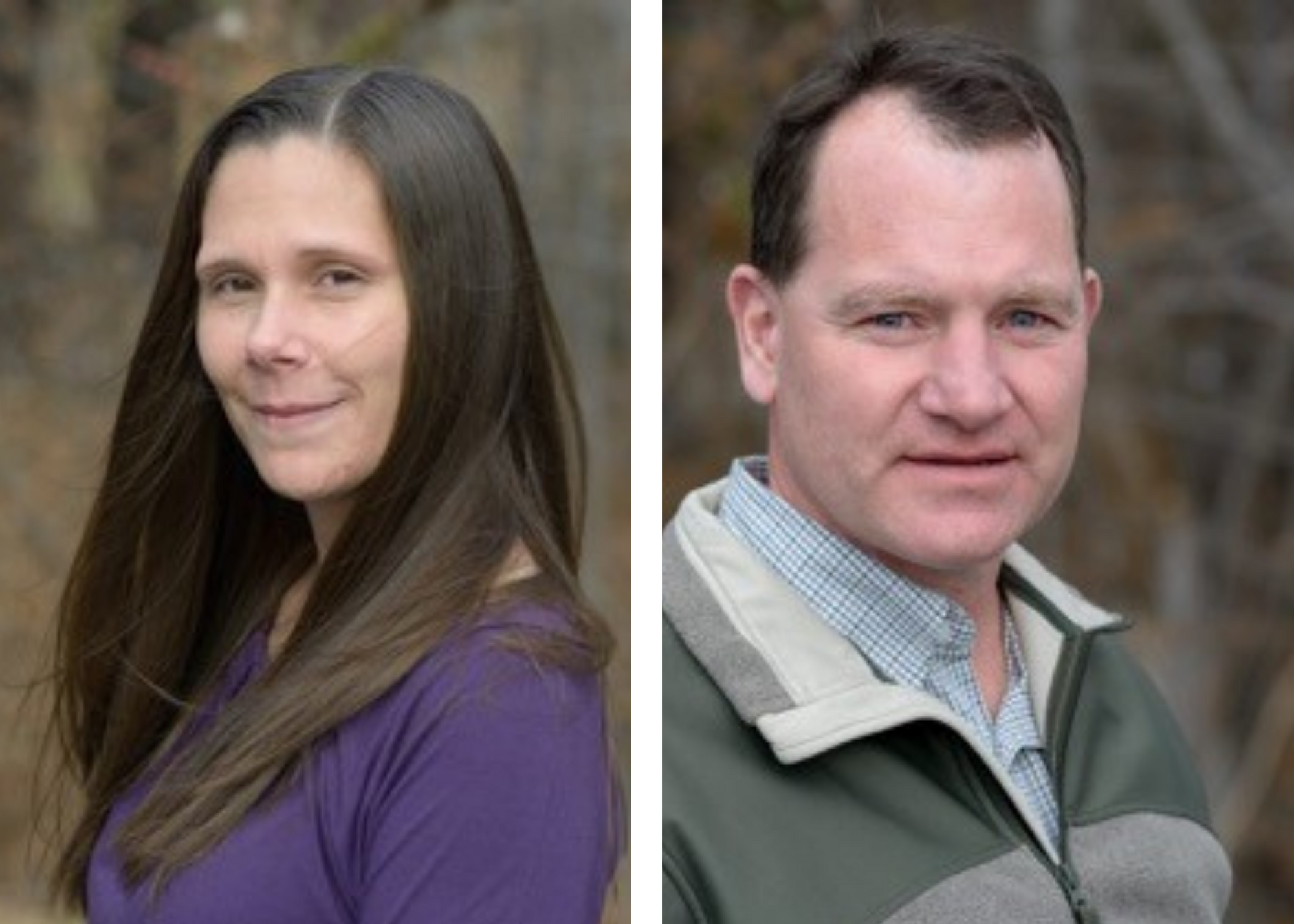
Rutland, VT — Kinney Pike Insurance, a leading independent insurance agency in Northern New England recently announced its top producers for 2020. These individuals were recognized for producing the most new business in both personal and commercial lines of insurance. Nicole Cattabriga has been honored as the winner of the 2020 Barwood Sales Achievement Award for personal lines insurance. Doug Allard has been honored with the 2020 Dorsey Award given to the commercial insurance Account Executive producing the top sales.
Cattabriga and Allard are both based out of Kinney Pike’s White River Junction location and competed against employees in five other offices located throughout Vermont. With the exceptional efforts of their sales and service teams, Kinney Pike has been successful in attracting new business and maintaining loyal customers since 1904.
The Barwood Award’s namesake is Wendell A. Barwood, who owned and operated the Barwood Insurance Agency in the Upper Valley region of Vermont for many years. Kinney Pike Insurance purchased the Barwood Agency in 1989. The Dorsey Award’s namesake is Stephen C. Dorsey, who first established the Kinney Pike Agency in 1904.
About Kinney Pike Insurance: Kinney Pike Insurance, founded in 1904, is one of the largest independent insurance agencies in Northern New England with six locations: Rutland, White River Junction, Williston, Randolph, St. Johnsbury, and Swanton. Kinney Pike is a full-service agency specializing in commercial insurance, personal insurance, and employee benefits.
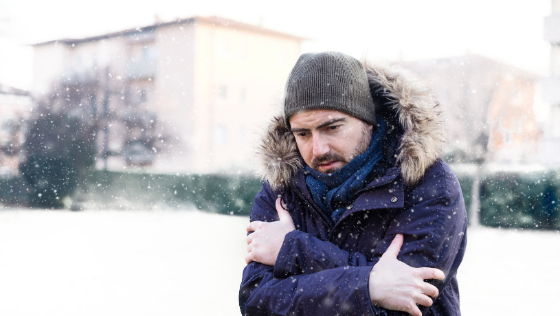
Cold stress is a condition caused by excessive exposure to extreme conditions including low temperatures, wind, and/or moisture. Unfortunately, winters in New England, make cold stress injuries a lot more common than you might think.
Vulnerable people include but are not limited to outdoor workers, those that work in poorly heated or insulated areas, those with reduced blood circulation, as well as those who have not dressed appropriately for extreme, cold conditions.
If you work in conditions that could lead to a cold stress injury, below we outline two of the most common types of injuries & how to treat them whether they happen to you or someone you know.
Symptoms:
Treatment:
Early symptoms:
Late Symptoms:
Treatment:
Now that you know the signs & symptoms of common cold stress injuries, here are some safety measures you can take to prevent them from happening in the first place, whether it be at your place of business or even your home.
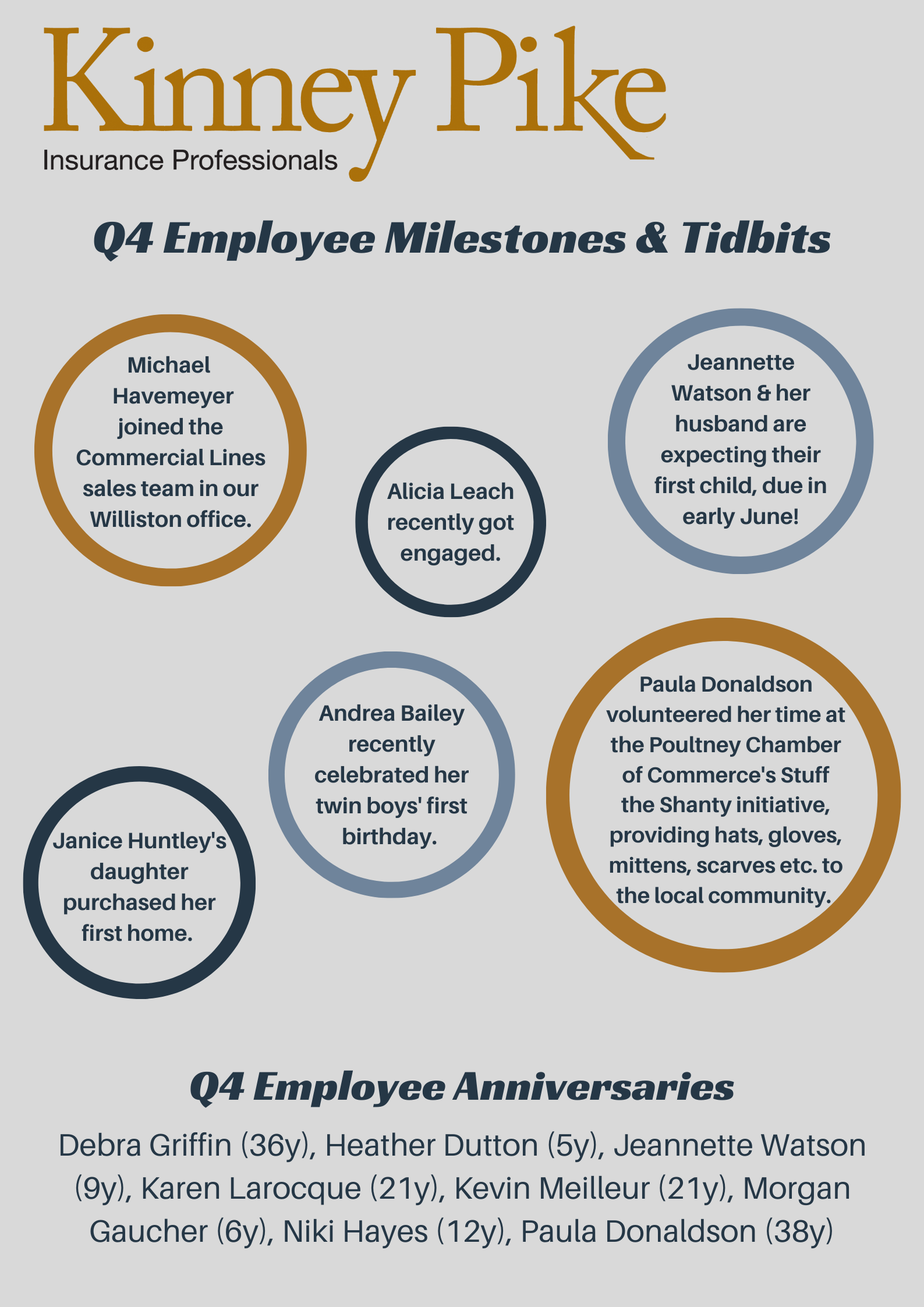

Williston, VT – Kinney Pike Insurance has added Michael Havemeyer as a new Account Executive handling Property & Casualty Insurance and expanding the Business Insurance sale teams in their Williston office.
Havemeyer joins Kinney Pike Insurance with 20 years of experience in the restaurant business in Vermont and New York, where he excelled in maintaining profitability and driving sales. As the newest member of the Williston Commercial Lines Account Executive team, Michael is excited to bring his knowledge to Kinney Pike and be a trusted insurance adviser for current and new clients.
“Adding Michael will help strengthen our organization and reinforce our commitment to being a key resource for our business clients,” said Doug Corman, one of three Kinney Pike Insurance Principals.
About Kinney Pike Insurance:
Kinney Pike Insurance, founded in 1904, is one of the largest independent insurance agencies in Northern New England with six Locations: Rutland, White River Junction, Williston, Randolph, St. Johnsbury, and Swanton. Kinney Pike is a full-service agency specializing in commercial insurance, personal insurance, and employee benefits. Kinney Pike holds the distinction of being Vermont’s only Assurex Global Partner, an exclusive partnership of the most prominent independent agents and brokers in the world. For further information, please contact Brittany Swift at 800.296.5722.
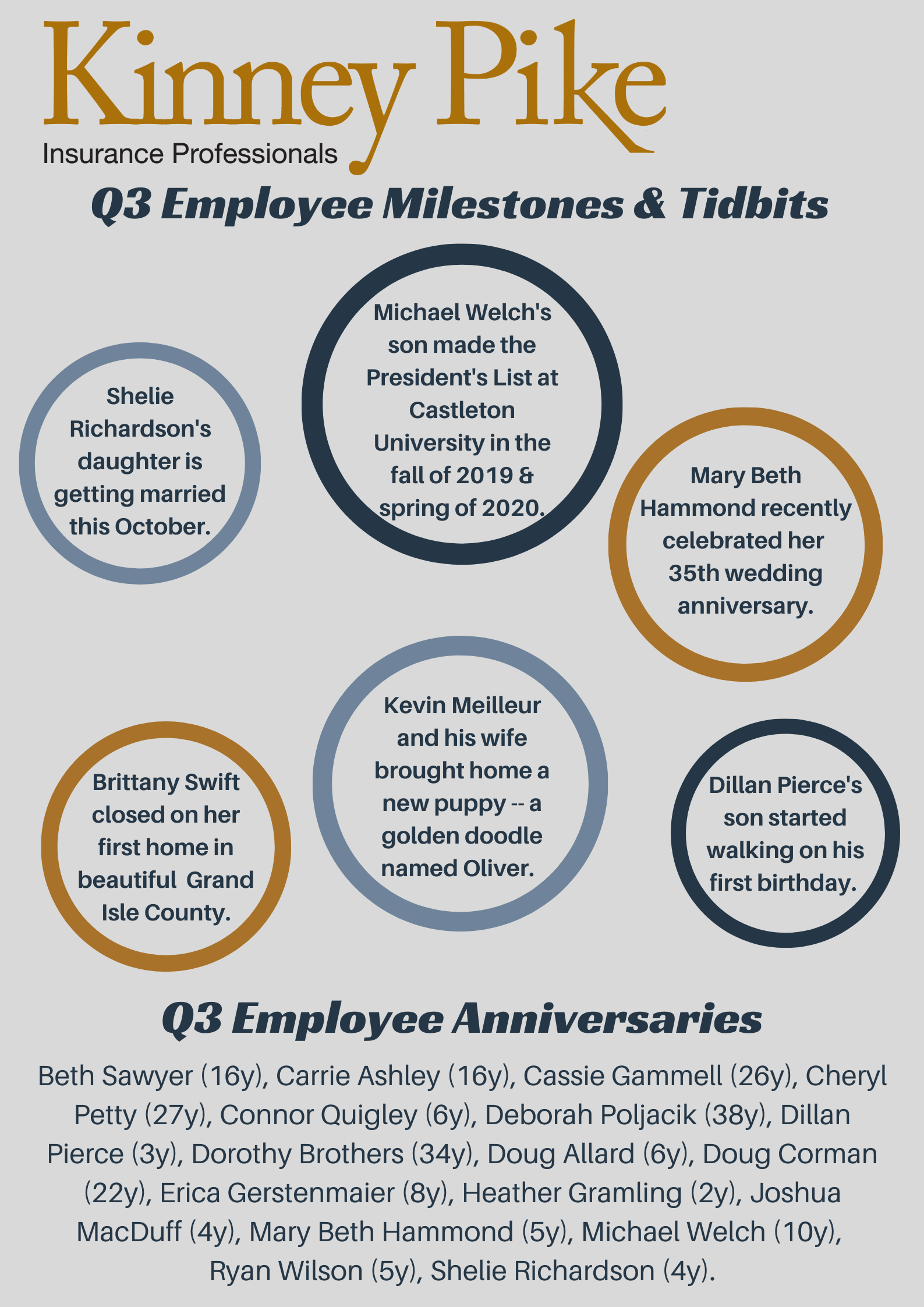
We understand that there’s a lot of information out there regarding COVID-19. To make things easier for you, we’ve compiled a list of all the major personal lines carriers we work with and included links to their individual responses to the current pandemic — this includes potential policy discounts. We hope this clarifies any unanswered questions you might have. If you have additional requests or you don’t see your carrier listed below, please feel free to contact us. Thank you!
Reminder: the following is intended to be used for general guidance purposes only — it does not constitute legal advice, nor does it represent a definitive position on insurance coverage.
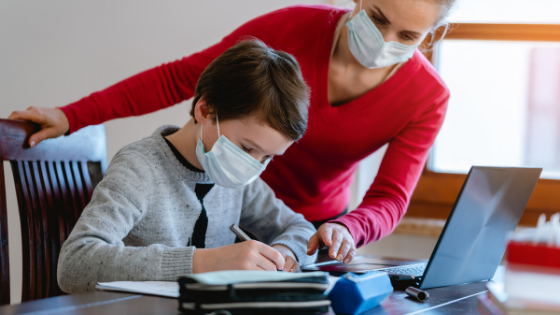
This year returning to school has taken on a new meaning, and there’s a new set of worries for those of you that are parents and caregivers — you must figure out how to balance the educational, social, and emotional needs of your kids, all while navigating a pandemic. We thought we’d remind everyone of some simple safety & hygiene tips to help keep your kids safe throughout this school year and beyond.
Side note: We realize state officials, schools, and teachers have most likely already discussed many of the suggestions below; however, we feel it’s important to reiterate the information.
Keep your hands clean.
This is such a simple & easy thing to do, and it can significantly impact the spread of germs…
Practice hand-washing at home with your children and explain why it’s essential to wash hands with soap and water for at least 20 seconds, especially before and after eating, coughing/sneezing, or adjusting a face mask.
Also, explain that if soap & water are not available, use hand sanitizer. Although most schools will be providing it, you should send your kids to school with a pocket-sized hand sanitizer just in case.
Stay home if you’re sick.
We understand every school may have a different policy on this… but If your child has a cold or flu symptoms, even if you don’t think it’s COVID, please be respectful of those around you and keep your child home unless you know for sure. If needed, contact your child’s doctor to get a COVID test.
This year, getting the influenza vaccine is also very important to reduce the risk of contracting the flu, seeing as most respiratory illnesses will send kids home from school and require COVID testing.
Clean & disinfect items that have been at school.
With most children attending school or child care facilities during the day — this means their belongings may get contaminated with COVID and other germs.
Have multiple cloth face masks available for your child. Provide your child with a clean mask and back-up mask each day and a clean, resealable bag to store the mask in when they can’t wear it, such as at lunch.
Have a stash of disinfecting wipes at home to wipe down school books, folders, lunch boxes, and other common touchpoints. Schools should also be following CDC guidelines on proper disinfecting and sanitizing classrooms and common areas.
Be mindful of the transportation challenge.
Making sure your child travels safely to & from school can be particularly challenging during a pandemic. Depending on their age, walking or biking to school can be an easy way to have kids avoid the crowds on the school bus. If they choose to walk or bike, make sure you review the proper safety protocols with them, especially if you can’t be with them during these times.
If your children are taking the bus, make sure to get them to the bus stop a bit ahead of pick up time to promote a safe, masked and mindful entrance to the bus.
If you plan on driving them to & from school, this may require additional planning. You most likely won’t be allowed to enter the school building, as temperature checks will be taking place. Try to arrive a little early to avoid feeling rushed or confused; this will also help keep everyone on task and safe.
Don’t forget mental health.
This year has caused countless disruptions to daily life, and children are feeling these changes deeply, along with their regular growing pains. It’s essential to be calm and proactive in conversations with your kids –check-in with them to see how they are doing. Their emotions will change regularly, and you need to reassure them that that’s okay.
Children may also get frustrated or upset if they are finding it hard to wear a mask. You can remind them that many adults are working hard to help keep them safe, and explain that it’s important we all follow the recommended measures to take care of more vulnerable members of our society.
Article Sources:
https://newsnetwork.mayoclinic.org/discussion/safety-tips-for-returning-to-school-during-covid-19/
https://www.cdc.gov/coronavirus/2019-ncov/prevent-getting-sick/index.html
https://inside.upmc.com/kids-and-covid-safety-tips-for-back-to-school/
https://www.nsc.org/home-safety/seasonal-safety/back-to-school